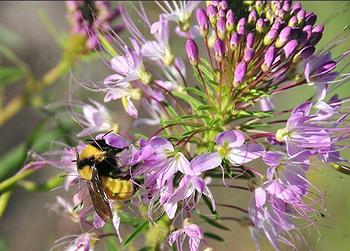
WASHINGTON, DC, August 6, 2018 (ENS) – The Trump administration’s U.S. Fish and Wildlife Service is reversing a 2014 ban on the use of bee-killing neonicotinoid pesticides and genetically modified crops that trigger greater pesticide use across the national wildlife refuge system.

Saying that these steps are necessary because, “Normal human expansion in our nation will continue to eliminate wildlife habitats that have previously been relied upon for successful wildlife restoration,” the Service’s Principal Deputy-Director Gregory Sheehan said that without these measures birds and other wildlife cannot meet their needs for food as private farmland is lost.
The decision, made public August 2, comes a day after the California’s Department of Pesticide Regulation released a new analysis finding that four widely used “neonic” pesticides can cause much broader harm than previously thought to pollinators commonly found on many vegetables, fruits and grains, including crops like corn and sorghum that are frequently grown in wildlife refuges.
The National Wildlife Refuge Service will now decide when and where to apply neonic pesticides and plant genetically modified crops on a “case-by-case basis,” said Sheehan.
“Agricultural pesticides, especially bee-killing neonics, have no place on our national wildlife refuges,” said Hannah Connor, a senior attorney at the Center for Biological Diversity, who this year authored a report documenting the annual use of nearly half a million pounds of toxic pesticides on America’s wildlife refuges.
“This huge backward step will harm bees and other pollinators already in steep decline simply to appease pesticide-makers and promote mono-culture farming techniques that trigger increased pesticide use,” said Connor. “It’s senseless and shameful.”

In July 2014 the National Wildlife Refuge system announced it would ban use of neonics and genetically modified crops that cause increased pesticide use on national wildlife refuges. The ban was an effort to ensure that management of the refuges that were created to provide natural habitats for wildlife “restores or mimics natural ecosystem processes…”
Informed by the growing body of scientific research showing the broad harm neonicotinoids pose to bees and other pollinators, earlier this year the European Union banned neonics for outdoor uses in agriculture.
Europe’s decision came after Canada’s pesticide regulatory agency recommended banning imidacloprid, the most widely used neonicotinoid, based on demonstrated harms to aquatic ecosystems.
One of the most important findings of the new California neonic analysis is the discovery of the high risk to bees posed by use of two neonicotinoids, thiamethoxam and clothianidin, on cereal grains like corn, wheat, rice and sorghum.
“Wildlife refuges are places where we should be protecting wildlife, not promoting use of highly toxic poisons on row crops,” said Connor. “All the strongest scientific evidence leaves no doubt we should move aggressively toward banning all outdoor use of these harmful neonics, yet the Trump administration is aggressively expanding their use.”
Most genetically altered crops are designed to make them resistant to herbicides like glyphosate and dicamba, which in turn allows farmers to increase their use of these pesticides in summer when many animals are out foraging.

It’s been well-documented that use of the pesticide glyphosate on crops genetically altered to resist it has played a role in the 80 percent decline of monarch butterflies over the past two decades because it kills milkweed, the only food of the monarch caterpillar.
But Connor said that because over-use of glyphosate, the active ingredient in the pesticide Roundup, has fueled the growth of glyphosate-resistant superweeds across millions of U.S. acres, Monsanto developed seeds that are now resistant to both glyphosate and dicamba, a drift-prone pesticide that, as described in a recent analysis by the Center for Biological Diversity, may be even more harmful to monarchs than glyphosate.
In 2015, the World Health Organization classified glyphosate as a probable human carcinogen. Now hundreds of cancer victims and their families are suing Monsanto, the originator of glyphosate, for not informing them of the cancer risk.
Still, other citizens’ groups support the reversal of this ban.
Ducks Unlimited and the National Wild Turkey Federation, NWTF, applauded the reversal, saying the ban “…decreased food availability and management options for waterfowl and other wildlife.”
“Ducks Unlimited and the NWTF advocate for science-based decision making,” said Ducks Unlimited CEO Dale Hall.

“That includes bringing attention to decisions that restrict effective wildlife management and were clearly not based on science,” said Hall. “We are pleased the USFWS reversed this decision and restored this essential tool for waterfowl and wildlife management to our National Wildlife Refuges.”
“We applaud the Service’s recognition that their farming practices must stay current with common products and technology to sustain wildlife populations the refuge system was created to conserve,” said NWTF CEO Becky Humphries.
Hall says that, “While there is no consensus that GMO crops are dangerous to human health, there are concerns about chemical use in farming operations, which are needed to effectively produce quality crops.”
He points out that to safeguard against the use of any chemicals dangerous to wildlife, refuges are required to submit a pesticide use proposal for approval by contaminant specialists in the USFWS.
Hall is confident that, “Through this process, potential threats to people or wildlife will be fully addressed.”
But Connor is not persuaded. “In 2017 alone,” she says, “dicamba sprayed on genetically engineered crops spurred thousands of reports of drift damage to more than 3.6 million acres of nearby crops, forests and natural areas. Early estimates from 2018 indicate that 1.1 million acres have been similarly damaged so far this year.”
© 2018, Environment News Service. All rights reserved. Content may be quoted only with proper attribution and a direct link to the original article. Full reproduction is prohibited.
